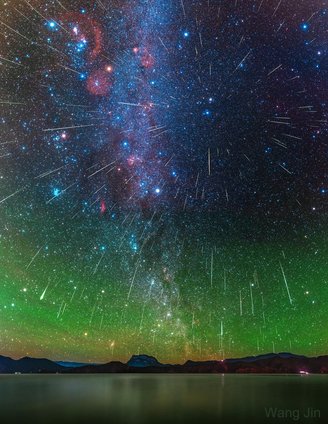The last month of the year has arrived, and with it countless skyscapes that will delight observers and astronomy enthusiasts around the world! In December, The night sky will transform into a star scene filled with spectacular events, from planetary conjunctions to dazzling meteor showers.
As always, we have prepared a selection of the main astronomical events that will brighten up the last nights of the year for you to put on your calendar and get your observation tools ready!
December’s astronomical events will result from the solstice, which symbolizes the arrival of summer in the Southern Hemisphere, and the Geminids, the main meteor shower of the year.
Summer will start in Brazil on December 22, at 00:27 Brazilian time.. On this day, the Earth’s South Pole will tilt towards the Sun, which has reached its southernmost position in the sky, and fall directly on the Tropic of Capricorn. This will be the longest day in the Southern Hemisphere and the shortest day in the Northern Hemisphere, where winter will begin.

But the main astronomical event of December is It will occur on the night of the 13th and in the early morning hours of the 14th, when the activity of the Geminid meteor shower will reach its peak. the most famous and beloved among astronomers in the world!
Considered the “king” of meteor showers, the Geminids produce up to 120 multicolored meteors per hour at their peak. It consists of the remnants left behind by the asteroid 3200 Phaethon, which was discovered in 1982.
This event takes place every year from December 7th to 17th, and the peak of this year’s event will be powered by the almost new phase of the Moon, which will provide darker skies for a perfect show!
Geminids are best viewed after midnight in a dark place. Meteors will radiate from the constellation Gemini, but they can appear anywhere in the sky.
Using applications such as Carta Celeste, Stellarium and SkyMap are great allies for observing and identifying objects in the sky!
Calendar of major astronomical events for December 2023
04/12: Mercury at maximum western elongation (best visibility)
05/12: In the First Quarter of the Month
12/12: New month
13 and 14/12: Maximum activity of the Geminid meteor shower
12/19: In the First Quarter of the Month
12/21 and 22: Maximum activity of the Ursid meteor shower
12/22: Summer Solstice and conjunction of the Moon and Jupiter in the Southern Hemisphere
12/27: full moon
Clear skies and good observations!
Always stay informed about celestial events on TecMundo and get the opportunity to share the lunar calendar with your friends who enjoy astronomy!
Source: Tec Mundo
I’m Blaine Morgan, an experienced journalist and writer with over 8 years of experience in the tech industry. My expertise lies in writing about technology news and trends, covering everything from cutting-edge gadgets to emerging software developments. I’ve written for several leading publications including Gadget Onus where I am an author.












